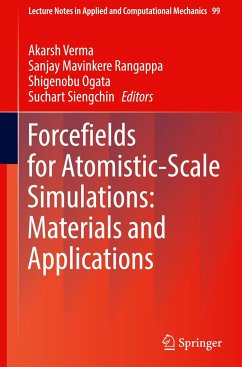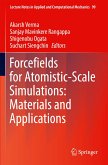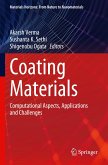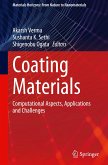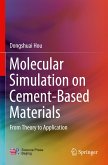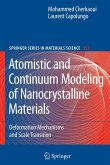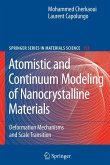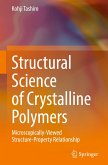Forcefields for Atomistic-Scale Simulations: Materials and Applications
Herausgegeben:Verma, Akarsh; Mavinkere Rangappa, Sanjay; Ogata, Shigenobu; Siengchin, Suchart
Forcefields for Atomistic-Scale Simulations: Materials and Applications
Herausgegeben:Verma, Akarsh; Mavinkere Rangappa, Sanjay; Ogata, Shigenobu; Siengchin, Suchart
- Gebundenes Buch
- Merkliste
- Auf die Merkliste
- Bewerten Bewerten
- Teilen
- Produkt teilen
- Produkterinnerung
- Produkterinnerung
This book describes the forcefields/interatomic potentials that are used in the atomistic-scale and molecular dynamics simulations. It covers mechanisms, salient features, formulations, important aspects and case studies of various forcefields utilized for characterizing various materials (such as nuclear materials and nanomaterials) and applications. This book gives many help to students and researchers who are studying the forcefield potentials and introduces various applications of atomistic-scale simulations to professors who are researching molecular dynamics.
Andere Kunden interessierten sich auch für
![Forcefields for Atomistic-Scale Simulations: Materials and Applications Forcefields for Atomistic-Scale Simulations: Materials and Applications]() Forcefields for Atomistic-Scale Simulations: Materials and Applications134,99 €
Forcefields for Atomistic-Scale Simulations: Materials and Applications134,99 €![Coating Materials Coating Materials]() Coating Materials64,99 €
Coating Materials64,99 €![Coating Materials Coating Materials]() Coating Materials90,99 €
Coating Materials90,99 €![Molecular Simulation on Cement-Based Materials Molecular Simulation on Cement-Based Materials]() Dongshuai HouMolecular Simulation on Cement-Based Materials75,99 €
Dongshuai HouMolecular Simulation on Cement-Based Materials75,99 €![Atomistic and Continuum Modeling of Nanocrystalline Materials Atomistic and Continuum Modeling of Nanocrystalline Materials]() Laurent CapolungoAtomistic and Continuum Modeling of Nanocrystalline Materials112,99 €
Laurent CapolungoAtomistic and Continuum Modeling of Nanocrystalline Materials112,99 €![Atomistic and Continuum Modeling of Nanocrystalline Materials Atomistic and Continuum Modeling of Nanocrystalline Materials]() Laurent CapolungoAtomistic and Continuum Modeling of Nanocrystalline Materials112,99 €
Laurent CapolungoAtomistic and Continuum Modeling of Nanocrystalline Materials112,99 €![Structural Science of Crystalline Polymers Structural Science of Crystalline Polymers]() Kohji TashiroStructural Science of Crystalline Polymers150,99 €
Kohji TashiroStructural Science of Crystalline Polymers150,99 €-
-
-
This book describes the forcefields/interatomic potentials that are used in the atomistic-scale and molecular dynamics simulations. It covers mechanisms, salient features, formulations, important aspects and case studies of various forcefields utilized for characterizing various materials (such as nuclear materials and nanomaterials) and applications. This book gives many help to students and researchers who are studying the forcefield potentials and introduces various applications of atomistic-scale simulations to professors who are researching molecular dynamics.
Produktdetails
- Produktdetails
- Lecture Notes in Applied and Computational Mechanics 99
- Verlag: Springer / Springer Nature Singapore / Springer, Berlin
- Artikelnr. des Verlages: 978-981-19-3091-1
- 1st edition 2022
- Seitenzahl: 404
- Erscheinungstermin: 20. August 2022
- Englisch
- Abmessung: 241mm x 160mm x 28mm
- Gewicht: 770g
- ISBN-13: 9789811930911
- ISBN-10: 9811930910
- Artikelnr.: 63906762
- Herstellerkennzeichnung
- Springer-Verlag GmbH
- Tiergartenstr. 17
- 69121 Heidelberg
- ProductSafety@springernature.com
- Lecture Notes in Applied and Computational Mechanics 99
- Verlag: Springer / Springer Nature Singapore / Springer, Berlin
- Artikelnr. des Verlages: 978-981-19-3091-1
- 1st edition 2022
- Seitenzahl: 404
- Erscheinungstermin: 20. August 2022
- Englisch
- Abmessung: 241mm x 160mm x 28mm
- Gewicht: 770g
- ISBN-13: 9789811930911
- ISBN-10: 9811930910
- Artikelnr.: 63906762
- Herstellerkennzeichnung
- Springer-Verlag GmbH
- Tiergartenstr. 17
- 69121 Heidelberg
- ProductSafety@springernature.com
Dr. Akarsh Verma is working as an Assistant Professor at the University of Petroleum and Energy Studies, Dehradun, India. He obtained Ph.D. in Mechanical Engineering from the Indian Institute of Technology Roorkee, India, and did his postdoctoral research work at Osaka University, Japan, and Brigham Young University, USA. He serves the research community by acting as a reviewer for more than 50 international journals (for Nature, Elsevier, Springer, Sage, Taylor & Francis, Wiley, IOP, etc.). In addition, he has published more than 50 research articles in high-quality international peer-reviewed journals, 20 book chapters, one book, and also presented many research papers at various international/national conferences. His area of interest is computational mechanics, computational chemistry, quantum mechanics, molecular dynamics, nanocomposites, etc. He has various international fellowships/awards (Japan Society for the Promotion of Science (JSPS) Postdoctoral Fellowship, Japan; J. William Fulbright Doctoral Research Fellowship, USA; Early Career Training Grant award for Early Career Researchers from the Communications Materials (Nature Journal); Researcher Development Grant from the Royal Society of Chemistry (RSC), UK; Excellence in Doctoral Research Award for the Best Ph.D. thesis research work at Indian Institute of Technology (IIT) Roorkee, India; Doctoral Research Scholarship by the Department of Science and Technology (DST), Government of India and Ministry of Human Resource Development (MHRD), Government of India; PG Scholarship by the All India Council for Technical Education (AICTE), India) to his credit. He has also been recognized by Stanford University's list of the world's Top 2% of the Most-Cited Scientists in Single Year Citation Impact 2020. Dr. Sanjay Mavinkere Rangappa, is currently working as a Senior Research Scientist and also 'Advisor within the office of the President for University Promotion and Development towards International goals' at King Mongkut's University of Technology North Bangkok, Bangkok, Thailand. He has received the B.Engg (Mechanical Engineering) in the year 2010, M.Tech (Computational Analysis in Mechanical Sciences) in the year 2013, Ph.D (Faculty of Mechanical Engineering Science) from Visvesvaraya Technological University, Belagavi, India in the year 2018 and Post Doctorate from King Mongkut's University of Technology North Bangkok, Thailand, in the year 2019. He is a Life Member of Indian Society for Technical Education (ISTE) and an Associate Member of Institute of Engineers (India). Also acting as a Board Member of various international journals in the fields of materials science and composites. He is a reviewer for more than 100 international Journals (for Nature, Elsevier, Springer, Sage, Taylor & Francis, Wiley, American Society for Testing and Materials, American Society of Agricultural and Biological Engineers, IOP, Hindawi, NC State Univesity USA, ASM International, Emerald Group, BenthamScience Publishers, Universiti Putra, Malaysia), also a reviewer for book proposals, and international conferences. In addition, he has published more than 180 articles in high-quality international peer-reviewed journals indexed by SCI/Scopus, 9 editorial corners, 60 book chapters, one book, 25 books as an Editor (Published by lead publishers such as Elsevier, Springer, Taylor & Francis, Wiley), and also presented research papers at national/international conferences. In 2021, his 17 articles have got top-cited article status in various top journals (Journal of Cleaner Production, Carbohydrate Polymers, International Journal of Biological Macromolecules, Journal of Natural Fibers, Journal of Industrial Textiles). He is a lead editor of Several special issues. Based on google scholar, the number of citations amounts to 7250+ and his present H-index is 45 with i10-Index of 123. In addition, 1 Thailand Patent and 2 Indian patents are granted. He has delivered keynote and invited talks atvarious international conferences and workshops. His current research areas include Natural fiber composites, Polymer Composites, and Advanced Material Technology. He has received a 'Top Peer Reviewer 2019' award, Global Peer Review Awards, Powered by Publons, Web of Science Group. The KMUTNB selected him for the 'Outstanding Young Researcher' Award 2020. He is recognized by Stanford University's list of the world's Top 2% of the Most-Cited Scientists in Single Year Citation Impact 2019 and also for the year 2020. Prof. Dr. Shigenobu Ogata is working as Full Professor in the Department of Mechanical Science and Bioengineering in Osaka University. He is also Professor of the Elements Strategy Initiative for Structural Materials, Kyoto University. He received Ph.D. degree in Mechanical Engineering from Osaka University in 1998. He is an editor of Progress in Materials Science (Elsevier). He was Visiting Research Scientist in the Department of Nuclear Science and Engineering at MIT 2001-2002 and Research Affiliate at MIT 2003-now. He and his group aim to develop reliable theoretical models for describing various nonlinear multiscale and/or multiphysics phenomena that appear in solid materials and then to design materials with novel functions and a deformation process controlled at an atomic level in a predictive manner. Some mature and widely accepted models involve amorphous materials, deformation and strength of materials (such as describing the ideal shear strain of different materials and named the maximum shear strain shearability; revealing the formation mechanism of the shear band in metallic glass and amorphous metals), dislocation modelling, diffusion modelling, constitutive model, fundamental algorithms, structural materials and nanostructure. He has published over 170 peer-reviewed journal articles and received 6800+ citations. He also has published four books. His awards include Japanese Society of Mechanical Engineers (JSME) Young Engineer Award (2004), Japanese Society of Materials Science (JSMS) Award for Promising Researcher (2005), JSME Medal for Outstanding Paper (2007), The Japan Institute of Metals Best Paper Awards (Materials Physics 2010, Engineering Materials 2014, Mechanics 2017, Materials Physics 2021), Lee Hsun Lecture Award of Institute of Metal Research, China (2014), JSME Computational Mechanics Division, Computational Mechanics Achievement Award (2015), and JSMS Award for Academic Contribution (2016). Prof. Dr.-Ing. habil. Suchart Siengchin is President of King Mongkut's University of Technology North Bangkok (KMUTNB), Thailand. He received his Dipl.-Ing. in Mechanical Engineering from University of Applied Sciences Giessen/Friedberg, Hessen, Germany, M.Sc. in Polymer Technology from University of Applied Sciences Aalen, Baden-Wuerttemberg, Germany, M.Sc. in Material Science at the Erlangen-Nürnberg University, Bayern, Germany, Doctor of Philosophy in Engineering (Dr.-Ing.) from Institute for Composite Materials, University of Kaiserslautern, Rheinland-Pfalz, Germany and Postdoctoral Research from School of Materials Engineering, Purdue University, USA. In 2016 he completed the Habilitation (Dr.-Ing. habil.) in Mechanical Engineering from Chemnitz University of Technology, Saxony, Germany and worked as a Lecturer for Mechanical and Process Engineering Department at The Sirindhorn International Thai-German Graduate School of Engineering (TGGS), KMUTNB. He has been full Professor at KMUTNB and became the Vice President for Research and Academic Enhancement in 2012 and elected President of KMUTNB in November 2016. He won the Outstanding Researcher Award in 2010, 2012, 2013 at KMUTNB and National Outstanding Researcher Award for the year 2021 in engineering and industrial research by National Research Council of Thailand (NRCT). His research interests in Polymer Processing and Composite Material. He is Editor-in-Chief: Applied Science and Engineering Progress and International Advisory Board, eXPRESS Polymer Letters and Journal of Production Systems and Manufacturing Science and the author of more than 321 peer reviewed Journal Articles and edited more than 139 books and book chapters. He has participated with presentations in more than 49 International and National Conferences with respect to Materials Science and Engineering topics.
1. Introduction to Forcefields.- 2. Forcefields for characterization of metals/metal alloys.- 3. Forcefields for characterization of nuclear materials.- 4. Forcefields and Atomistic insights to study high entropy alloys.- 5. Coarse-grained forcefields for anisotropically interacting particles.- 6. Forcefields for 2D nanomaterials (Graphene and h-BN) and the universal solvent "water".- 7. Reactive forcefield (ReaxFF) for the combustion application.- 8. Reactive forcefield (ReaxFF) for the 2D nanomaterials synthesis.- 9. Forcefields and Modelling of Polymer Coatings and nanocomposites.- 10. Accelerated reactive forcefields for studying nanomaterials and polymers.
1. Introduction to Forcefields.- 2. Forcefields for characterization of metals/metal alloys.- 3. Forcefields for characterization of nuclear materials.- 4. Forcefields and Atomistic insights to study high entropy alloys.- 5. Coarse-grained forcefields for anisotropically interacting particles.- 6. Forcefields for 2D nanomaterials (Graphene and h-BN) and the universal solvent "water".- 7. Reactive forcefield (ReaxFF) for the combustion application.- 8. Reactive forcefield (ReaxFF) for the 2D nanomaterials synthesis.- 9. Forcefields and Modelling of Polymer Coatings and nanocomposites.- 10. Accelerated reactive forcefields for studying nanomaterials and polymers.

